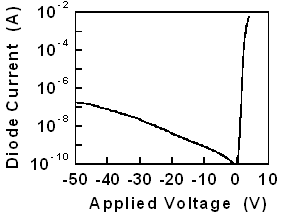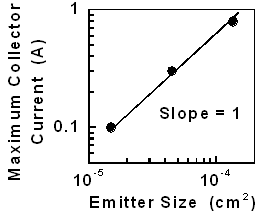Physical Science Laboratory
@Compared with Si and GaAs, nitride semiconductors have high breakdown voltage
because of their wide bandgap. On the other hand, one of the characteristics
of a heterojunction bipolar transistor (HBT) is high current density. Therefore,
a nitride HBT is a promising electronic device in terms of both materials
and device types. However, there are two issues for the nitride HBT. One is
a relatively low current gain and the other is a high offset voltage in the
common-emitter current-voltage (I-V) characteristics. As a result, high-power
characteristics of a nitride HBT have not been reported, though they are theoretically
expected.
@We have developed a GaN/InGaN HBT. Our GaN/InGaN HBT uses a low-resistivity
p-InGaN layer as a base layer instead of the conventional p-GaN [1] and has
a double heterostructure for a high breakdown voltage [2]. To improve current
gain and reduce the offset voltage, we used a base regrowth technique. The
current gain increased 100 fold and the offset voltage was reduced to 1/10
compared with the previous record [3]. This time, we have investigated the
high-power characteristics of these GaN/InGaN HBTs.
@The base-collector junction is reverse-biased and the HBT power increases
with increasing reverse voltage. Figure 1 shows typical I-V characteristics
of a base-collector diode. The leakage current is small even at the reverse
bias voltage of -50 V because of the wide bandgap of the GaN collector. On
the other hand, the output power depends on the collector current in the common-emitter
I-V characteristics. Figure 2 shows the maximum collector current as a function
of the emitter size. As shown in this figure, the maximum collector current
is proportional to the emitter size. Since the breakdown voltage is independent
of the emitter size, the output power is proportional to the emitter size.
Up to now, we have obtained a maximum output power exceeding 10 W for a 90
Êm x 50 Êm emitter. The maximum power density is as high as 270,000 W/cm2
[4]. This is the first demonstration of high-power characteristics in a nitride
HBT.
| [1] | K. Kumakura et al., Jpn. J. Appl. Phys. 39 (2000) L337. |
| [2] | T. Makimoto et al., Appl. Phys. Lett. 79 (2001) 380. |
| [3] | T. Makimoto et al., Appl. Phys. Lett. 83 (2003) 1035. |
| [4] | T. Makimoto et al., Appl. Phys. Lett. 84 (2004) 1964. |
 |
 |
||||
|
|